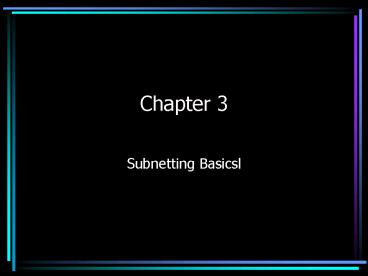Subnetting Basicsl - PowerPoint PPT Presentation
1 / 24
Title:
Subnetting Basicsl
Description:
Must take bits from the hostid part of the address. Always take from the ... PING 127.0.0.1 (localhost) TCP/IP stack intalled properly. PING host ip address ... – PowerPoint PPT presentation
Number of Views:1000
Avg rating:3.0/5.0
Title: Subnetting Basicsl
1
Chapter 3
- Subnetting Basicsl
2
Summary of the Three Classes of Networks
3
Subnetting
- Benefits
- Reduce Network Traffic
- Routers create Broadcast Domains
- Optimal Performance
- Simplified Management
- Capable of spanning long distances
- Subnets
- Allow you to break large networks into smaller
ones - Must take bits from the hostid part of the
address - Always take from the left most hostid bits
4
First Things First
- Determine the number of networks needed
- One for each subnetwork
- One for each WAN segment
- Determine the number of hosts required
- One for each TCP/IP host
- One for each Router interface
- Create the following
- A subnet mask for the entire network
- A subnet id for each network segment
- A range of host ids for each subnet segment
5
Subnet Masks
6
Subnetting Class C Addresses
- Class C address 8 host bits
- Subnetting
- 10000000 128
- 11000000 192
- 11100000 224
- 11110000 240
- 11111000 248
- 11111100 252
- 11111110 254
- Rules
- Cannot have only 1 bit for subnetting
- Subnets 128 254 are illegal
- Cisco allows 1 bit to be used for subnetting
- ip subnet-zero
7
The Binary Method using 2 bits
8
The Alternate Method
- 1. How many subnets does the subnet mask produce?
- 2x xnumber of bits for subnet
- 2. How many valid hosts per subnet? 2y
- ynumber of bits for host ids
- 3. What are the valid subnets?
- 256 subnet first subnetwork (block)
- add the block to subnetwork
- stop when subnet mask is reached
- 4. What is the broadcast address of each subnet?
- Next subnetwork 1
- 5. What are the valid hosts in each subnet?
- First Host Subnetwork 1
- Last Host Broadcast - 1
9
(No Transcript)
10
(No Transcript)
11
(No Transcript)
12
Subnetting Practice Examples
- Class C
- Page 108
- Class B
- Page 114
- Class A
- Page 120
13
Super Netting
- Using Network / Subnet bits
- Increase Number of hosts available
14
Variable Length Subnet Masks (VLSM)
- Previous examples have used 1 fixed length subnet
mask for entire network - Example 192.168.10.0/28
- 255.255.255.240
- How many hosts on each subnet?
15
(No Transcript)
16
(No Transcript)
17
VLSM
- Allows for a varying number of hosts on different
subnet segments - Uses different size subnet masks for different
subnet segments - Not Supported by RIP v1.0 or IGRP
- Classful routing
- RIP v2.0, OSPF, EIGRP support
- Classless routing
18
(No Transcript)
19
(No Transcript)
20
Trouble Shooting
- PING 127.0.0.1 (localhost)
- TCP/IP stack intalled properly
- PING host ip address
- Communicating with you NIC
- PING the gateway (ie the router)
- Physical connectivity
- PING Server ip address
- Network path
- PING Server FQDN
- DNS is working
21
Whats the Problem?
22
Whats the Problem?
23
Things to Know
- Calculating subnet mask, host addresses,
broadcast address - Understand the various block sizes
- VLSM
- Four diagnostic steps
- Find and Fixing IP address problems
24
(No Transcript)






























